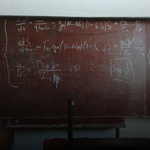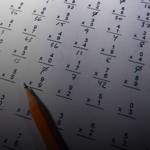Section 1
Preview this deck
Let f(x)= ln(2-x). The domain of f is
Front
Active users
0
All-time users
0
Favorites
0
Last updated
4 years ago
Date created
Mar 1, 2020
Cards (77)
Section 1
(50 cards)
Let f(x)= ln(2-x). The domain of f is
(-infinity, 2)
An equation for the line tangent to the curve y = (x^2 + x + 1)(x^3 − 2x + 2) at the point (1, 3) is
y=6x-3
Find the marginal revenue for the revenue function 50 − p(x 2 + 1) = 0.
(50(1-x^2))/(x^2+1)^2
What is the marginal profit in terms of the cost C(x) to produce x units and the unit price p(x) at which units will sell?
Find dy/dx in terms of x and y when x and y are related by the equation x^1/3+y^1/3=1
-(y/x)^2/3
Find an equation of the tangent line to the graph of y= x ln x at the point (1,0).
y=x-1
Let f(x)= (sqrt x+1)/(x-2). The domain of f is
[-1, 2) and (2, +infinity)
Find the limit as z approaches negative infinity (x^2+3)/(x+1)
None of the above
Find dy/dx in terms of x only when x and y are related by the equation ln y=2x-3.
2e^(2x-3)
Evaluate: limit as x approaches 3 (3x^2-4)
23
Find the limit as approaches 0 sqrt(1+x)-1/x
1/2
An equation for the line tangent to the curve y = x^3 −2x +5 at the point (-2, 1) is
y=10x+21
Find dy/dx at point (2, sqrt 5) when x and y are related by the equation 2x^2-y^2=3
4/sqrt5
Let y=sqrtu and u=7x-2x^2. Find dy/dx.
1/2(7-4x)(7x-2x^2)^-1/2
Find an equation of the tangent line to the graph of y= ln(x^2) at the point (2, ln 4).
y=x-2+ln4
Given the demand equation 4x+2p−36 = 0 and the supply equation 2x−p+10 = 0, where p is the unit price and x represents the quantity, find the equilibrium quantity and the equilibrium price.
x=2 and p=14
The distance s (in feet) covered by a car t seconds after starting from rest is given by s=-t^3+8t^2+2-t. Find the car's acceleration at time t.
-6t+16
Suppose that F(x)=f(x^2+1) and f'(2)=3. Find F'(1).
6
Find the vertical vertical asymptotes of function f(x)= (2+x)/(1-z)^2.
x=1
The absolute maximum value and the absolute minimum value of the function f(x) =1/2^x2 − 2√x on [0, 3] are
absolute min. value: -3/2; absolute max. value: 9/2 -2square root of 3
A ball is thrown straightly up into the air so that its height (in feet) after t seconds is given by s(t) = −16t^2 + 64t. The average velocity of the ball over the interval [1, 1.05] is... Assume that the distance function s(t) is given as in Problem 16. The velocity of the ball at time t = 1 is
31.2 ft/sec, 32 ft/sec
Suppose that F(x)=f(x)^2+1, f(1)=1, and f'(1)=3. find F'(1).
6
Let f(x)=1/x. When simplified, the difference quotient f(x+h)-f(x)/h becomes
-1/x(x+h)
let f(x)=1/x^2 and g(x)=3x+5. Then, (fog)(x) is
1/(3x+5)^2
Find the second derivative of the function f(x) = e x + ln(x^2) + x ln 3 + 10.
None of the above
Let f(x)=x/x^2+1 and g(x)=1/x. Then (gof)(x) is
x+1/x
The line tangent to y = x^2−3x through the point (1,-2) has equation
y=-x-1
Let f(x) = {2x-4 if x<0 1 if x>0,
f(x) is discontinuous at x=0
Suppose h=fog. Find h'(0) given that f(0)+6, f'(5)=-2, g(0)=5, and g'(0)=3.
-6
Let f(x)= x^2-4x. When simplified, the difference quotient f(x+h)-f(x)/h becomes
2x+h-4
Evaluate limit as z approaches 1- f(x) for the function f defined as f(x)= {(e^x, for 0<x<1)(3, for x=1)(lnx, for x>1)
e
For f(x) = sqrt(2 +√x), evaluate f'(4).
1/16
Find limit as x approaches 3 (x^2-9)/(x-3)
6
The third derivative of f(x)=1/x is
-6/x^4
What is the profit in terms of the cost C(x) to produce x units and the unit price p(x) at which x units will sell?
xp(x)-C(x)
The total weekly cost on dollars incurred by Herald Media Corp. in producing x DVDs is given by the total cost function C(x) = 2500 + 2.2x, 0 ≤ x ≤ 8000. The marginal cost and the average cost function are...
2.2, 2500/x+2.2
Find an equation of the tangent line to the graph of y=e^(−x^2) at the point (1, 1/e)
y = −2/e(x − 1) + 1/e
1. The domain of function f(x) =( x+3)/(2x^2−x−3)
(−∞, −1) ∪ (−1,3/2) ∪ (3/2,+∞)
Find the horizontal asymptotes of function f(x)= (x^2)/(1+4x^2)
y=1/4
Find an equation of the tangent line at the point (1, 32) of the graph of y = x(x+1)^5
y=112x-80
The derivative of the function f(x)= ((x-3)/(sqrt x+1)) + (sqrt3x+4)+3
None of the above
It is known that limit as x approaches 2+ f(x)=3, limit as x approaches 2- f(x) =3, and f(2)=1.
f(x) is discontinuous at x=2, The graph of f(x) is broken at x=2, lim as x approaches 2 f(x) exists, f(x) is defined at x=2
Find dy/dx in terms of x and y when x and y are related by equations x^2y-y^3=2.
(2xy)/(3y^2-x^2)
Evaluate: limit as x approaches 5 (x^2-2x-15)/(x-5).
8
Let f(x)=x^2+1 and g(x)=1/squareroot x. Then f(g(2)) is
3/2
Find the limit as x approaches infinity (3x^2+2x+4)/(2x^2-3x+1)
3/2
Find dy/dx in terms of x and y when x and y are related by equation 2x^2+y^2+2x^2y^2+10.
-(x(1+2y^2)/y(1+2x^2)
Evaluate: limit as z approaches infinity (x^2-1)/(3x^2-2)
1/3
The unit price p and the quantity x demanded are related by the demand equation 50 − p(x 2 + 1) = 0. Find the revenue function R = R(x).
50x/(x^2+1)
The second derivative of function f(x)=(x^2+1)^5 is
10(x^2+1)^3(9x^2+1)
Section 2
(27 cards)




